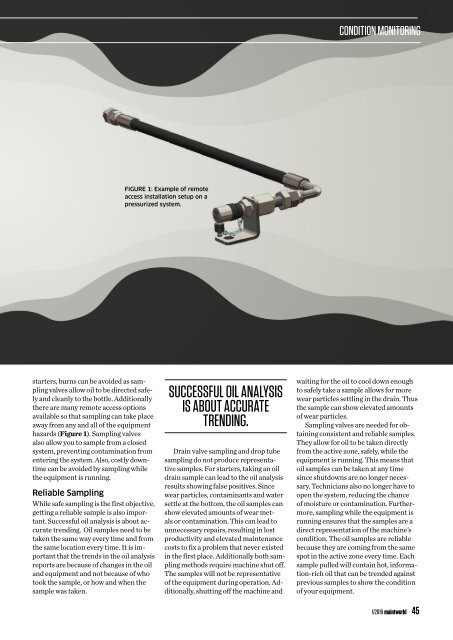Maintworld 1/2018
The Use and Misuse of Vibration Analysis // The Industrial Iot Maturity Model // Condition Monitoring in Maritime Applications // Effective Backlog Management
The Use and Misuse of Vibration Analysis // The Industrial Iot Maturity Model // Condition Monitoring in Maritime Applications // Effective Backlog Management
You also want an ePaper? Increase the reach of your titles
YUMPU automatically turns print PDFs into web optimized ePapers that Google loves.
CONDITION MONITORING<br />
FIGURE 1: Example of remote<br />
access installation setup on a<br />
pressurized system.<br />
starters, burns can be avoided as sampling<br />
valves allow oil to be directed safely<br />
and cleanly to the bottle. Additionally<br />
there are many remote access options<br />
available so that sampling can take place<br />
away from any and all of the equipment<br />
hazards (Figure 1). Sampling valves<br />
also allow you to sample from a closed<br />
system, preventing contamination from<br />
entering the system. Also, costly downtime<br />
can be avoided by sampling while<br />
the equipment is running.<br />
Reliable Sampling<br />
While safe sampling is the first objective,<br />
getting a reliable sample is also important.<br />
Successful oil analysis is about accurate<br />
trending. Oil samples need to be<br />
taken the same way every time and from<br />
the same location every time. It is important<br />
that the trends in the oil analysis<br />
reports are because of changes in the oil<br />
and equipment and not because of who<br />
took the sample, or how and when the<br />
sample was taken.<br />
SUCCESSFUL OIL ANALYSIS<br />
IS ABOUT ACCURATE<br />
TRENDING.<br />
Drain valve sampling and drop tube<br />
sampling do not produce representative<br />
samples. For starters, taking an oil<br />
drain sample can lead to the oil analysis<br />
results showing false positives. Since<br />
wear particles, contaminants and water<br />
settle at the bottom, the oil samples can<br />
show elevated amounts of wear metals<br />
or contamination. This can lead to<br />
unnecessary repairs, resulting in lost<br />
productivity and elevated maintenance<br />
costs to fix a problem that never existed<br />
in the first place. Additionally both sampling<br />
methods require machine shut off.<br />
The samples will not be representative<br />
of the equipment during operation. Additionally,<br />
shutting off the machine and<br />
waiting for the oil to cool down enough<br />
to safely take a sample allows for more<br />
wear particles settling in the drain. Thus<br />
the sample can show elevated amounts<br />
of wear particles.<br />
Sampling valves are needed for obtaining<br />
consistent and reliable samples.<br />
They allow for oil to be taken directly<br />
from the active zone, safely, while the<br />
equipment is running. This means that<br />
oil samples can be taken at any time<br />
since shutdowns are no longer necessary.<br />
Technicians also no longer have to<br />
open the system, reducing the chance<br />
of moisture or contamination. Furthermore,<br />
sampling while the equipment is<br />
running ensures that the samples are a<br />
direct representation of the machine’s<br />
condition. The oil samples are reliable<br />
because they are coming from the same<br />
spot in the active zone every time. Each<br />
sample pulled will contain hot, information-rich<br />
oil that can be trended against<br />
previous samples to show the condition<br />
of your equipment.<br />
1/<strong>2018</strong> maintworld 45

















